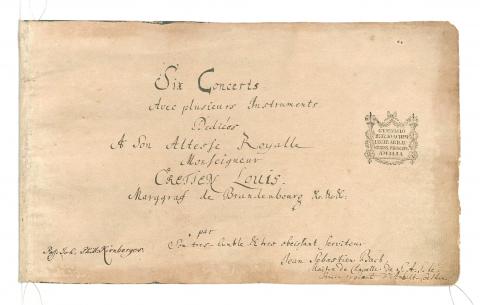On March 24, 1721, Johann Sebastian Bach completed the Brandenburg Concertos for the Margrave of Brandenburg-Schwedt.
The concertos belong to the genre of concerto grosso, popular during the Baroque period. This was structured as the concertino small group of soloists playing instruments selected for their distinct color, accompanied by a larger group of instruments known as the ripieno. Playing together in contrast or in combination, the concertino section and the ripieno ensemble created a mixture of musical colors.
Bach is revered as the greatest composer of all time for his ability to consistently break the mold of tradition in ingenious ways. By selecting a wide range of instruments to stand out in different pieces within the collection, Bach was able to demonstrate his command of the distinctive voice of the instruments commonly used in court ensembles.

Photo: Staatsbibliothek zu Berlin, Public Domain
圖片:柏林國家圖書館
In Concerto No. 1, Bach immediately parts with convention by starting the whole collection with all instruments playing in concert, and achieves a sublime symphonic opening where the more intimate atmosphere typical of court chamber music would traditionally have been employed. The piece closes with a minuet, reminiscent of the elegance of traditional Baroque court music.
Being closest to the concerto grosso form, the concertino section in No. 2 is an eclectic selection of four instruments with very different sounds — a valveless natural trumpet with the sound of a hunting horn, the recorder, the oboe and the violin — creating a unique effect.
Intriguingly, Concerto No. 3 is without a concertino, being a string ensemble accompanied by basso continuo: violin, viola, cello, with three of each, interweaving and conversing with one another.
The concertino section in Concerto No. 4 comprises two flauti d’echo (echo flutes) and a violin: The two woodwind instruments play in sequence and follow the violin melody, creating an echo effect.
Perhaps Bach’s most audacious innovation appears in Concerto No. 5, in which the harpsichord, traditionally serving as accompaniment, takes the lead. In this, the whole piece paves the way for subsequent concertos for keyboard instruments.
Concerto No. 6 once again lacks a concertino section, but this time is even without violins. The combination of violas and a variety of different Baroque viols creates a dark, brooding effect.
The Brandenburg Concertos were, essentially, Bach’s resume for applying to a position in the Prussian court to further his career. Once received, however, the manuscript was stored in the Margrave’s library, and was not to be published until more than a hundred years later, when the manuscript was rediscovered. They never would be played in the Margrave’s court.
(Paul Cooper and Chang Ho-ming, Taipei Times)
約翰‧塞巴斯蒂安‧巴赫在一七二一年三月二十四日完成《布蘭登堡協奏曲》,並將其獻給布蘭登堡-施韋特的伯爵。
就樂曲類型而言,這組協奏曲作品屬於巴洛克時期盛行的「大協奏曲」,由一小組樂器音色較為突出的獨奏家組成「獨奏部」,搭配規模較大的另一組「伴奏部」組成。兩個聲部一起演奏時,「獨奏部」與「伴奏部」既呈現出彼此音色的對比,時而合力齊奏,創造出千變萬化的音樂色彩。
巴赫之所以受後人尊崇為最偉大的作曲家,原因來自他屢屢能在陳舊的形式中另闢蹊徑。巴赫在整組作品裡面選用了各式各樣的樂器,讓它們在各曲中展現突出的音色,同時以此呈現自己對於宮廷樂團裡各種常見樂器的充分掌握。
在第一號協奏曲的開頭,巴赫率先跳出傳統框架,讓所有樂器一起演奏,塑造出宛如交響曲般的崇高氣質,藉以展開整組作品,迥異於宮廷室內樂典型的親密氛圍。音樂最後以小步舞曲收尾,讓人懷想傳統巴洛克宮廷音樂的優雅性格。
第二號協奏曲就形式而言最接近於「大協奏曲」,獨奏部卻特異地選擇四把音色截然不同的樂器──宛如狩獵號角、沒有音栓的自然小號,加上直笛、雙簧管,以及小提琴──創造出獨特的聲響效果。
第三號協奏曲令人玩味地不含獨奏部,取而代之的是一組弦樂團,附帶「數字低音」的伴奏:小提琴、中提琴,與大提琴各三把,互相交織、對話。
第四號協奏曲的獨奏部由兩把「回聲的笛子」與一把小提琴組成。在音樂中,兩把木管樂器互相應和,偶亦追隨小提琴的旋律,製造出回音般的效果。
巴赫最大膽的創新或許可見於第五號協奏曲,以往多半擔任伴奏的大鍵琴在此一躍成為音樂主角。這項創舉成為後世鍵盤樂器協奏曲的濫觴。
第六號協奏曲再度不見獨奏部,這回甚至連小提琴都沒有用到。中提琴與多種巴洛克大提琴的組合,呈現出深沉而共鳴豐富的聲響效果。
《布蘭登堡協奏曲》本質上像是一封履歷,巴赫希望藉此在普魯士宮廷中謀得一職,尋求更進一步的生涯發展。布蘭登堡伯爵收到這部作品後竟將它從此束之高閣。一百多年後,這份手稿才被人發現,並首度印行出版,只可惜其中的音樂從來不曾於伯爵的宮廷中演奏。
(台北時報章厚明撰)

In an effort to fight phone scams, British mobile phone company O2 has introduced Daisy, an AI designed to engage phone con artists in time-wasting conversations. Daisy is portrayed as a kindly British granny, exploiting scammers’ tendency to target the elderly. Her voice, based on a real grandmother’s for authenticity, adds to her credibility in the role. “O2” has distributed several dedicated phone numbers online to direct scammers to Daisy instead of actual customers. When Daisy receives a call, she translates the scammers’ spoken words into text and then responds to them accordingly through a text-to-speech system. Remarkably, Daisy

Bilingual Story is a fictionalized account. 雙語故事部分內容純屬虛構。 Emma had reviewed 41 resumes that morning. While the ATS screened out 288 unqualified, she screened for AI slop. She could spot it a mile away. She muttered AI buzzwords like curses under her breath. “Team player.” “Results-driven.” “Stakeholder alignment.” “Leveraging core competencies.” Each resume reeked of AI modeling: a cemetery of cliches, tombstones of personality. AI wasn’t just changing hiring. It was draining the humanity from it. Then she found it: a plain PDF cover letter. No template. No design flourishes. The first line read: “I once tried to automate my

Every May 1, Hawaii comes alive with Lei Day, a festival celebrating the rich culture and spirit of the islands. Initiated in 1927 by the poet Don Blanding, Lei Day began as a tribute to the Hawaiian custom of making and wearing leis. The idea was quickly adopted and officially recognized as a holiday in 1929, and leis have since become a symbol of local pride and cultural preservation. In Hawaiian culture, leis are more than decorative garlands made from flowers, shells or feathers. For Hawaiians, giving a lei is as natural as saying “aloha.” It shows love and

1. 他走出門,左右看一下,就過了馬路。 ˇ He walked outside, looked left and right, and crossed the road. χ He walked outside and looked left and right, crossed the road. 註︰並列連接詞 and 在這句中連接三個述語。一般的結構是 x, y, and z。x and y and z 是加強語氣的結構,x and y, z 則不可以。 2. 他們知道自己的弱點以及如何趕上其他競爭者。 ˇ They saw where their weak points lay and how they could catch up with the other competitors. χ They saw where their weak points lay and how to catch up with the other competitors. 註:and 一般連接同等成分,結構相等的單詞、片語或子句。誤句中 and 的前面是子句,後面是不定詞片語,不能用 and 連接,必須把不定詞片語改為子句,and 前後的結構才相等。 3. 她坐上計程車,直接到機場。 ˇ She took a cab, which took her straight to the airport. ˇ She took a cab and it took her straight